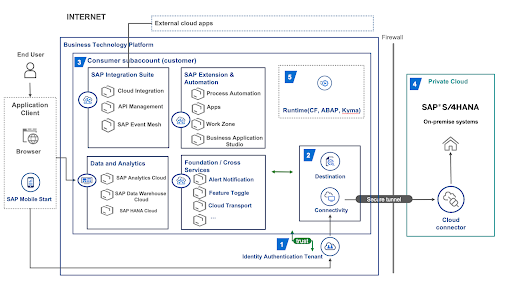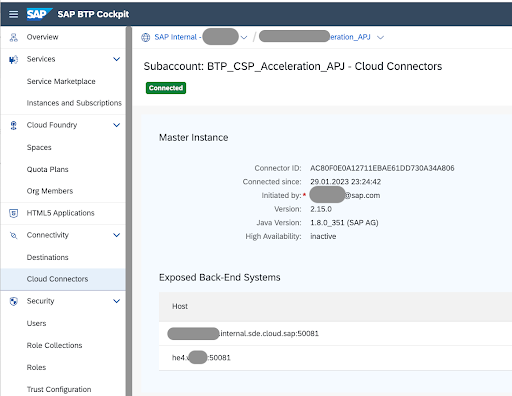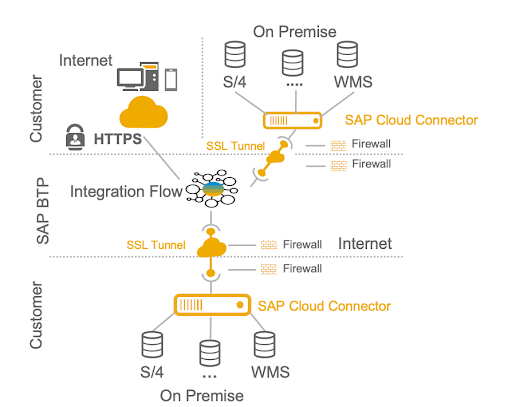Every business must analyze and transform data collected from its operations into something valuable and that is where SAP BTP comes in. SAP BTP is a set of technologies that enable the rapid and efficient transformation of data into value. Data is collected and stored in various mediums, resulting in a disrupted flow of information.
There is a free service derived from SAP BTP called Sap BTP Architecture. Sap BTP Architecture is a stable architecture that is simple to extend from both the customer and SAP perspectives. It is also integrated into other SAP cloud solutions, such as SAP success factor and SAP S/4 Hana cloud.
SAP BTP Architecture is also known as the Identity Authentication Service. It functions as a proxy, and many services must be connected through it. It focuses on providing a cloud-native environment that supports application development, extensibility, and integration. Organizations can optimize workflows, enable innovation, and improve operational efficiency by unifying capabilities across these domains.
An Overview Of SAP BTP Architecture
SAP BTP Architecture uses a multilayered structure to support a variety of business processes. This includes environment, services, infrastructure, etc.
Global Accounts
This is the outcome of a contract signed with SAP. This is one of the most important aspects of SAP BTP Architecture. This account is used to control directories, subaccounts, members, entitlements, and quotas.
Directory
This feature enables users to organize and manage their sub-accounts based on technical and business requirements. A directory can be made up of directories and subaccounts, which creates a hierarchy. Directories can be used to group other directories and subaccounts, or they can be created directly under the global account.
Subaccounts
This feature enables someone to structure a global account according to their organization. In addition, according to the project’s requirements in terms of members, authorization, and entitlements. A global account contains one or more subaccounts where applications, services, and subscriptions are properly managed.
When designing the landscape and overall architecture, it is critical to consider security, member management, data management, integration, and so on. Subaccounts in a global account are not mutually dependent.
The particular region is relevant when one deploys applications and accesses the SAP BTP Cockpit using the corresponding cockpit URL.
Entitlements
This is also an important thing to know about SAP BTP Architecture. Entitlement is the right to provision and consumption of a resource. They are also service plans that anyone is entitled to use. A service plan is a representation of the costs and benefits of a given variant of a particular service.
Region
A region is selected at the sub-account level. Each region represents a geographical location. Each subaccount requires one region. There are so many factors on which the selection of a region is dependent. For example, application performance can be optimized by choosing a region close to the user.
Infrastructure
This is another thing to know in SAP BTP Architecture. The infrastructure layer of a region is provided either by SAP or one of SAP’s Infrastructure. It can be as a service (IaaS) partners, Amazon Web Services (AWS), Microsoft Azure, Google Cloud Platform (GCP) and Alibaba Cloud. This synchronization with major cloud providers enables SAP BTP to provide highly available, scalable and geographically distributed infrastructure, offering resilience and
Environment
The environment constitutes the actual platform as a service offering of SAP BTP that allows for the development and administration of business applications. Each environment includes the tools, technologies, and runtime necessary for application development. It is anchored in SAP BTP at the subaccount level. This is one aspect of SAP BTP Architecture that should be understood.
Environment Available For Applications
1. The Cloud Foundry Environment
It is an open-source, cloud-native platform as a service (PaaS). A set of specifications and tools covering the entire application development life cycle. This includes applications deployment, application lifecycle management, security, and so on. This enables the creation of polyglot cloud applications.
2. The KYMA Environment
This environment provides a fully managed Kubernetes runtime based on the open source project “kyma.” Kubernetes is identical to cloud Foundry. Kubernetes is an open-source, cloud-native platform for managing the application lifecycle. It focuses more on containers, container orchestration, and scalability. The KYMA environment can be used to deploy microservices or develop full-stack applications.
3. The ABAP Environment
The ABAP environment is a cloud-enabled environment that exists within the cloud foundry or KYMA environment. It is built on the latest ABAP platform cloud release, which is also used by SAP S/4 HANA Cloud. This environment supports the ABAP RESTful Application Programming Model (RAP), which includes SAP Fiori and Core Data Services (CDS).
Services
It enables, facilitates, or speeds up the development of business applications. SAP BTP also offers other platform services. The SAP BTP discovery center contains a complete list of available services.
SAP BTP Architecture : Architect Salaries
The SAP BTP Architect salary is determined by several factors, including location, experience, and company size. An architect’s salary at SAP is estimated to be between $172k and $261k per year, which includes the base salary as well as additional payments. The average annual salary is $167k. The additional payment, which includes cash bonus, commission, stock, profit sharing, or tips, is $43,000.
SAP BTP Architecture: Diagram
SAP can be used for a variety of purposes, including role management, connections, and destinations. Also included are the concepts of entitlement, trust configurations, subaccounts, and spaces. Here are some diagrams and explanations that will help anyone navigate the SAP BTP Architecture.
1. Tenant-based identity authentication
This is a free service that can be created using SAP BTP and is also included in many other SAP cloud solutions, such as SAP Successfator and SAP S/4 HANA Cloud. This means there’s no need to create it again on SAP BTP if the user already has one, and usually one of these services is sufficient for his or her production needs. It is sometimes referred to as IAS (Identity Authentication Service). Additionally, this is not a BTP-based service, but rather an identity authentication service developed independently by SAP for better interconnection with its cloud products. To enable seamless login to SAP cloud products, connect common Microsoft authentication data to IAS and use existing user data and permissions. Create and populate users from 0 to 1, and rely heavily on IAS to achieve SAP cloud Product user management.

2. Connectivity And Destination
This is an extremely important aspect of BTP. To understand BTP’s architecture, someone must first understand how it works. It functions as a proxy, and many services must pass through it to communicate. Knowing how to create and use different services on BTP will likely help someone understand the design concept presented by the SAP BTP product team. This concept entails maintaining connection details in BTP and allowing different services to reuse them in different contexts. To retrieve all the Data Services of the background system at once, for instance, import the relevant connection details into SAP Build Apps.
The local on-premise system behind the firewall is located on the right side of the design below. It is necessary to connect to BTP via the SAP Cloud Connector (described below), after which various BTP services can process and communicate data using the virtual address exposed by the connection.

3. Customer Subaccount, and Space
A customer subaccount is a hierarchical concept with greater granularity. It has independent user roles, computing resources, service allocation, connectivity, and destination, among other features. The majority of the services exist in a specific customer subaccount. For example, if the user purchased two SAP integration suite tenants, he or she can only assign them to two separate sub-accounts.
The discovery center shows that the BTP’s services are roughly divided into several categories, including application development and automation, data and analysis, integration, and AI services. Its central idea is to shift toward low-code and no-code.
For example, the SAP integration suite is a tool for manipulating APIs without having to write code. SAP process automation also employs a code-free approach for robot development and approval flow management. SAP Build Apps is currently one of the most popular code-free application development tools. SAP’s Build WorkZone can create code-free enterprise portals, and SAP Analytics Cloud can create and analyze BI reports in a low-code environment. Traditional professional code development tools, such as Business Application Studio and the Cloud Foundry runtime environment, remain active.
4. SAP Cloud Connector
SAP Cloud Connector (SCC) is not a component of SAP BTP, but it is used with it. It is a reverse proxy installed on the user’s local machine where the user’s (Fourth generation SAP business Suite) S/4 HANA system is located for a private deployment. There is no need to individually configure each service on BTP. This is because BTP and its services are public network concepts that can be exposed to resources securely, swiftly, and conveniently through the cloud connector. If the whitelist is processed or the port is exposed and there is a problem, the user can access the log records via the cloud connector. Please keep in mind that one end of the SAP cloud connector must be BTP, while the other end can be the ERP system, locally developed Java server, and so on.

5. BTP Runtime (An Extremely Important Concept)
When it comes to development, some readers may be familiar with the concept of Cloud Foundry. In fact, it is an open-source cloud platform framework. Not only is this environment important for application development and deployment, but all BTP services rely on it. Hence, the user must create a Cloud Foundry environment and space before creating services such as SAP Integration Suite. The reason for this is that each application and service requires a runtime environment, which is provided by containers and Cloud Foundry. To set up a Cloud Foundry environment, the user must first create a Space, which is a more fine-grained hierarchical level within a subaccount where he or she can assign corresponding members and deploy corresponding applications.
Furthermore, SAP has recently added the ABAP and Kyma environments to improve development efficiency. The former, as the name implies, provides an ABAP development environment. The latter is intended for high-end players who are dissatisfied with BTP’s scaling function and need cloud development tools like K8S.
Final Word
SAP BTP has evolved alongside a more stable architecture. Extending from both the customer and SAP perspectives. The SAP BTP Architecture is built around flexibility, integration, and modularity. It includes global accounts, subaccounts, regions, and the environment.